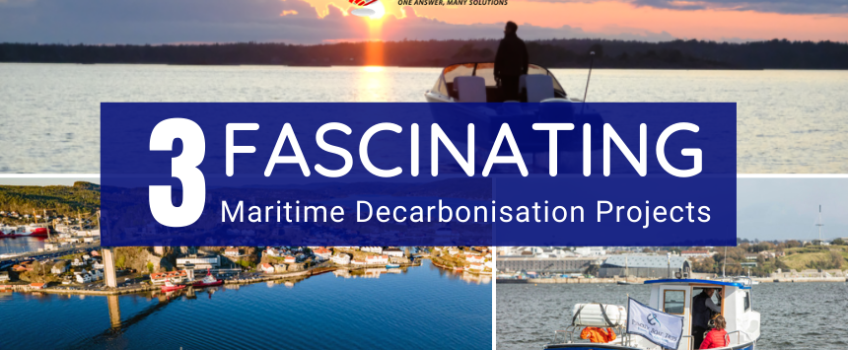
The shipping industry is vital for world trade as 90% of goods are transported by sea. However, it is also one of the most carbon-intensive industries along with aviation that contributes to climate change due to its reliance on fossil fuels. This brings us to the decarbonisation of the maritime sector but it is easier said than done. In this article, discover three incredibly innovative projects that could set the tone for decarbonising global shipping.
The Importance Of Maritime Decarbonisation
In the maritime industry, the IMO’s (International Maritime Organisation) Initial GHG Strategy aims to reduce the total GHG emissions internationally by at least 50% by 2050. It’s estimated that maritime greenhouse gas emissions account for approximately 2.5% of the global total which means decarbonisation efforts are needed. In truth, it may be an ambitious decarbonisation goal but recent developments in next-gen E-boats look promising.
Decarbonisation Efforts Using e-Boats
Whilst shipping giants such as Maersk are continuously looking to solutions like green methanol as an alternative fuel source for ocean-going cargo and container ships, electrification could be a more viable option for boats that venture closer to shore for easy and regular recharging.
From speed boats to ferries and even small container ships, E-boats could be the starting point in decarbonising the maritime industry. Here is some inspiring, cutting-edge engineering to help the shipping world go “greener”.
The Candela 7 Hydrofoil

In 2014, Gustav Hasselskog came up with the Candela 7 whilst boating in the Stockholm Archipelago. He realised that fossil fuel planing powerboats consume a substantial amount of energy due to the high drag. More specifically, they consume about 15 times more energy than a normal family car. The current battery technology isn’t quite there yet to fully electrify them so he came up with an ingenious concept.
The result was submerged hydrofoils which would lift the hull out of the water which effectively eliminates friction and drag. After several years of tinkering and engineering, the Candela Seven was born.
This electric foiling speedboat is almost like an aircraft flying above the waves rather than riding them. When cruising at 20 knots, the boat can cover 50 nautical miles on one charge but at the top speed of 30 knots, the range drops to 32 nautical miles.
The e-Voyager

For those with £200k to spare, a slightly less exhilarating but no still vital e-boat project is commencing soon on England’s south coast. The e-Voyager, formally known as the diesel-powered Mermaid, is a 12-passenger ferry.
Developed by Voyager Marine in partnership with Plymouth Boat Trips and E-Marine Solutions, it has been converted into a fully electric vessel. It could very well be the UK’s first seagoing electric passenger vessel. They fitted it with a 140kW motor in place of the old Ford 60hp (45kW) diesel engine.
The batteries are repurposed Nissan Leaf batteries enclosed within a specially designed and built marine casing. At the cruising speed of five knots, e-Voyager can operate for more than four hours. The recent installation of 1kW solar panels will also help extend the range.
Yara Birkeland Autonomous Electric Vessel

For a quick glimpse of what that future of shipping might look like, we go to Scandinavia for a closer look at a fascinating project combining electrification and autonomy. The Yara Birkeland is set to start operating later this year and will be the world’s first battery-powered autonomous vessel.
This 120 TEU container ship is designed to load, navigate and unload its cargo with nearly no human input. A 7MWh battery will power the vessel driving two 900kW azimuth thruster pods and two 700kW tunnel thrusters. It will have a top speed of 13 knots and a cruising speed of 6 to 7 knots.
Whilst the vessel appears operational, the autonomous aspect of logistics on land are not quite there yet. Yara has admitted to ongoing struggles with the electrified cargo solution for loading the Birkeland but all efforts are being made to find solutions.
Final Thoughts On Decarbonisation Of Global Shipping
The issues that Yara has experienced should serve as a reminder that it’s not easy to integrate complex, autonomous and electrified systems. Even with incredible advancements in technology, zero-carbon fuels and vessels are not yet a reality.
Environmental regulation could help the industry overcome certain barriers but there’s no clear direction in terms of which measures will be agreed upon and how quickly. Whether these E-boats are pathfinder projects for widespread adoption in the future remains to be seen.
If the maritime sector is serious about decarbonisation to reduce emissions, small and large vessels must follow the electrification path. Technology advancement and stakeholder engagement are both equally important in decarbonisation efforts in the maritime industry.
Recommended: ‘Could Autonomous Ships Help Marine Freight Transport?’
Conclusion
Simply improving energy efficiency will not be enough to reach the IMO’s decarbonisation goal. Fact is, commercially viable, zero-emission vessels must start entering the global fleet by 2030 at the very least. By financing research and development, though, we could hopefully speed up the development of next-gen technologies which will help create more sustainable shipping.
PRV Engineering works closely with several industries including maritime, oil and energy, aerospace, defence, construction and rail. We work with basic mild steels to the more exotic Monel, Inconel, Hastelloy and Titanium providing one-off projects, large batch production or Rapid Prototyping.
Our state-of-the-art facility in Pontypool provides CNC machining, 5-Axis machining, waterjet cutting, deep hole drilling and structural steel fabrication services among many others. If you have any questions about our range of engineering and fabrication services, please visit the website.


 Mail:
Mail: 



